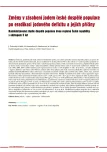Iodine and thyroid hormones
Authors:
R. Bílek; J. Čeřovská
Authors‘ workplace:
Endokrinologický ústav, Praha, ředitel doc. MUDr. Vojtěch Hainer, CSc.
Published in:
Vnitř Lék 2006; 52(10): 881-886
Category:
Original Contributions
Overview
During the period 1995-2002, the urinary iodine concentration and serum thyroglobulin (TG, n = 3902), thyrotropin (TSH, n = 5162), free thyroxine (FT4, n = 5160), and free triiodothyronine (FT3, n = 4931) was determined in randomly selected population (n = 5263, 2276 male, 2987 female, with age varied from 6 to 98 years) of seven counties from Czech Republic. The measurement of iodine was based on alkaline ashing of urine specimens preceding Sandell-Kolthoff reaction. The thyroid hormones, TSH, and TG was determined in serum using immunoassays. The individuals were divided to the groups according their iodine deficiency, i.e. to the group with urinary iodine concentration < 50, 50-100, 100-200, and >200 µg I/L of urine. In these groups the mean and median of TG, TSH, FT4, and FT3 was calculated. The means and medians of TG and FT4 was increased with the decrease of urinary iodine, and TSH was decreased with the decrease of urinary iodine. The values of FT3 were relatively independent on changes in concentrations of iodine in urine. All the hormonal changes was fallen to the normal reference ranges. It is evident from our results that in the situation of iodine deficiency, when the concentration of TSH is decreased, the sensitivity of thyrocytes on TSH stimulation must be increased to active the increased concentrations of TG and FT4. TG was also the most appropriate indicator of iodine nutrition from all observed hormones.
Key words:
iodine - thyroglobulin - thyrotropin - thyroxine - triiodothyronine
Sources
1. Zamrazil V, Pohunková D, Vavrejnová V et al. Prevalence of thyroid diseases in two samples of Czech population. A preliminary study. Endocrinol Exp 1989; 23 : 97-104.
2. Zamrazil V, Bílek R, Čeřovská J et al. The elimination of iodine deficiency in the Czech Republic: the steps towards success. Thyroid 2004; 14 : 49-56.
3. WHO. Assessment of iodine deficiency disorders and monitoring their elimination. 2nd ed. 2001. Publication WHO/NHD/01.1.
4. Bílek R, Bednář J, Zamrazil V. Spectrophotometric determination of urinary iodine by the Sandell-Kolthoff reaction subsequent to dry alkaline ashing. Results from the Czech Republic in the period 1994-2002. Clin Chem Lab Med 2005; 43 : 573-580.
5. Dumont JE, Lamy F, Roger PP et al. Physiological and pathological regulation of thyroid cell proliferation and differentiation by thyrotropin and other factors. Physiological Rev 1992; 72 : 667-697.
6. Wolff J, Chaikoff IL. Plasma inorganic iodide as a homeostatic regulator of thyroid function. J Biol Chem 1948; 174 : 555-564.
7. Chong W, Shan ZY, Sun W et al. Multivariate analysis of relationships between iodine biological exposure and subclinical thyroid dysfunctions. Chin Med Sci J 2005; 20 : 202-205.
8. Li HS, Carayanniotis G. Iodination of tyrosyls in thyroglobulin generates neoantigenic determinants that cause thyroiditis. J Immunol 2006; 176 : 4479-4483.
9. Dunn JT. What's happening to our iodine? J Clin Endocrinol Metab 1998; 83 : 3398-3400.
10. Larsen PR, Davies FT, Schlumberger MJ. Thyroid physiology and diagnostic evaluation of patients with thyroid disorders. In: Larsen PR, Kronenberg HM, Melmed S et al. Williams Textbook of Endocrinology. 10th ed. Philadelphia : WB Saunders 2003 : 360-361.
11. Fisher DA. Physiological variations in thyroid hormones: physiological and pathophysiological considerations. Clin Chem 1996; 42 : 135-139.
12. van den Briel T, West CE, Hautvast JG et al. Serum thyroglobulin and urinary iodine concentration are the most appropriate indicators of iodine status and thyroid function under conditions of increasing iodine supply in schoolchildren in Benin. J Nutr 2001; 131 : 2701-2706.
Labels
Diabetology Endocrinology Internal medicineArticle was published in
Internal Medicine

2006 Issue 10
Most read in this issue
- Hashimoto’s encephalopathy
- Radionuclid screening in endocrinology
- Autoimmune thyroiditis - selected etiopathogenic mechanisms
- Congenital adrenal hyperplasia due to 3-β-hydroxysteroid dehydrogenase deficiency
